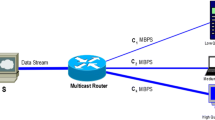Abstract
Current source-adaptive layered multicast schemes exploit merging capabilities at special nodes in the network to combine feedback from the multicast group. The merging procedures reduce network load and avoid feedback implosion at the source. In this paper, we demonstrate how to increase the efficiency of a merger node. We show how to tune two mechanisms: “feedback transmission”, on the timer settings used by receivers, and “temporal merging”, on the timer settings used by intermediate nodes. Our approach is generic, relating purely to timer settings, and does not touch on “content merging”, or the decision regarding which packets to forward. We investigate the effects of temporal merging on packet suppression. We show that periodic feedback transmission coupled with a suitable timer setting at the merger node increases efficiency.
Similar content being viewed by others
References
M.D. Amorim, O.C.M.B. Duarte and G. Pujolle, Single-loop packet merging for receiver oriented multicast multi-layered video, in: Proc. of International Conference in Computer Communications, Tokyo, Japan (1999).
S. Bajaj et al., Improving simulation for network research, Technical report, University of Southern California, Department of Computer Science (1999).
S. Blake et al., An architecture for differentiated services, Internet RFC 2475 (1998).
L.H.M.K. Costa, S. Fdida and O.C.M.B. Duarte, A scalable algorithm for link-state QoS-based routing with three metrics, in: Proc. of IEEE ICC’2001, Helsinki, Finland (2001).
E. Crawley, R. Nair, B. Rajagopalan and H. Sandick, A framework for QoS-based routing, Internet RFC 2386 (1998).
P.A. da Silva Gonçalves, J.F. de Rezende and O.C.M.B. Duarte, An active service for multicast video distribution, Journal of the Brazilian Computer Society 7(1) (2000) 43–51.
M.D. de Amorim, O.C.M.B. Duarte and G. Pujolle, Multi-criteria arguments for improving the fairness of layered multicast applications, in: Lecture Notes in Computer Science, Vol. 1815 (2000) pp. 1–10.
M.D. de Amorim, O.C.M.B. Duarte and G. Pujolle, Application-aware multicast, in: Proc. of GLOBECOM’2001, San Antonio, TX (2001).
C. Diot, C. Huitema and T. Turletti, Multimedia applications should be adaptive, in: Proc. of HPCS’95 (1995).
S.K. Kasera et al., Scalable fair reliable multicast using active services, IEEE Network 14(1) (2000) 48–57.
X. Li, S. Paul and M.H. Ammar, Layered Video Multicast with Retransmission (LVMR): Evaluation of hierarchical rate control, in: Proc. of IEEE INFOCOM’98, San Francisco, CA (1998) pp. 1062–1072.
Q. Ma and P. Steenkiste, Quality of service routing for traffic with performance guarantees, in: Proc. of IFIP International Workshop on Quality of Service, New York, USA (1997).
S. McCanne, V. Jacobson and M. Vetterli, Receiver-driven layered multicast, in: Proc. of SIGCOMM’96, Stanford, CA (1996) pp. 117–130.
C. Papadopoulos, G. Parulkar and G. Varghese, An error control scheme for large-scale multicast applications, in: Proc. of IEEE INFOCOM’98, San Francisco, CA (1998) pp. 1188–1196.
R. Rejaie, D. Estrin and M. Handley, Quality adaptation for congestion controlled video playback over the Internet, in: Proc. of ACM SIGCOMM’99, Cambridge, MA (1999).
R. Rejaie, M. Handley and D. Estrin, Layered quality adaptation for Internet video streaming, IEEE Journal on Selected Areas in Communications 18(12) (2000).
J. Shin, J. Kim and C.-C.J. Kuo, Quality of service mapping mechanism for packet video in differentiated services network, IEEE Transactions on Multimedia 3(2) (2001) 219–231.
B.J. Vickers, C. Albuquerque and T. Suda, Adaptive multicast of multi-layered video: Rate-based and credit-based approachs, in: Proc. of IEEE INFOCOM’98, San Francisco, CA (1998).
B.J. Vickers, M. Lee and T. Suda, Feedback control mechanisms for real-time multipoint video services, IEEE Journal on Selected Areas in Communications 15(3) (1997) 512–530.
Z. Wang and J. Crowcroft, Quality of service routing for supporting multimedia applications, IEEE Journal on Selected Areas in Communications 14(7) (1996).
B. Whetten and G. Taskale, An overview of Reliable Multicast Transport Protocol II, IEEE Network 14(1) (2000) 37–47.
A. Ziviani, J.F. de Rezende, O.C.M.B. Duarte and S. Fdida, Evaluating voice traffic in a differentiated services environment, in: Proc. of 17th International Teletraffic Congress – ITC17, Salvador, Brazil (2001).
Author information
Authors and Affiliations
Rights and permissions
About this article
Cite this article
Da Silva Gonçalves, P.A., de Rezende, J.F., Duarte, O.C.M.B. et al. Improving Feedback Merging for Source-Adaptive Layered Multicast Schemes. Cluster Comput 8, 77–88 (2005). https://doi.org/10.1007/s10586-004-4438-3
Issue Date:
DOI: https://doi.org/10.1007/s10586-004-4438-3




